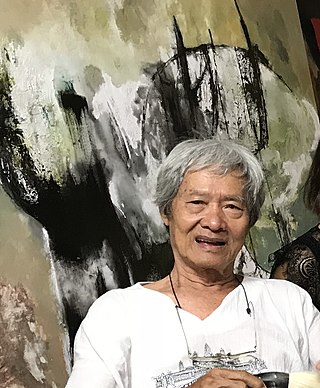
Trường Chinh was a Vietnamese communist political leader and theoretician. He was one of the key figures of Vietnamese politics. He played a major role in the anti-French colonialism movement and finally after decades of protracted war in Vietnam, the Vietnamese defeated the colonial power. He was the think-tank of the Communist Party who determined the direction of the communist movement, particularly in the anti-French colonialism movement. After the declaration of independence in September 1945, Trường Chinh played an important role in shaping the politics of the Democratic Republic of Vietnam (DRV) and creating the socialist structure of the new Vietnam.

Vietnamese art is visual art that, whether ancient or modern, originated in or is practiced in Vietnam or by Vietnamese artists.
The Vietnam University of Fine Arts is an art school in Hanoi, Vietnam originally established under French colonial rule in 1925. The university has trained many of Vietnam’s leading artists and each year it participates in many cultural exchanges with sister institutions overseas.
The Ministry of Industry and Trade is the government ministry in Vietnam responsible for the advancement, promotion, governance, regulation, management and growth of industry and trade. The former Ministry of Trade has its origins in 1945 with the formation of the modern National Unification Cabinet, and became a ministry in its own right in 1955. The Ministry of Trade merged with the Ministry of Industry in 2007 to form the Ministry of Industry and trade. The current Minister of Industry and Trade is Nguyễn Hồng Diên. Ministry main offices are located in Hanoi.
Thavibu Gallery is an art gallery and art book publisher in Bangkok, Thailand.
Công Quốc Hà is an acclaimed Vietnamese artist and lacquer painter. He was born in Hanoi in 1955 and graduated from the Hanoi Industrial Fine Arts College.
Trần Văn Cẩn was a Vietnamese painter.

Nguyen Phan Chanh was born in a rural Vietnamese village, in Ha Tinh province. His early education was in Chinese, and he studied Chinese calligraphy so as to pass the qualifying exams for the title of Mandarin. However, the exams were abolished before he was old enough to sit them. With his first ambition thwarted, it was decided that he should continue studying painting at the l’Ecole des Beaux-arts d’Indochine in Hanoi.

Phan Kế An, also known under the pseudonym Phan Kích, was a Vietnamese painter and renowned lacquer artist. He was the son of Phan Kế Toại (1892–1973) who was the personal envoy to Tonkin of the last Emperor of Vietnam, Bảo Đại, the Minister of Home Affairs (1945-1955) and former deputy prime minister of North Vietnam from 1955-1973.
Nha San Collective is the first and longest-running, non-profit, artist-run space for experimental art that was realized in the political scene in Vietnam. It has been a pioneer in facilitating an experimental art movement and in promoting contemporary culture.
Nguyen Manh Hung is a Vietnamese multidisciplinary artist based in Ho Chi Minh City.
Nguyễn Trinh Thi is a Hanoi-based independent filmmaker, documentarian, and video artist. She is known for her layered, personal, and poetic approach to contentious histories and current events through experiments with the moving image. Regarded as one of the pioneers of her home country Vietnam's independent cinema, Thi is seen as the most notable video artist in Vietnam's contemporary art scene. She plays an important role in the country's cinema, with works shown in international festivals and exhibitions.
The tradition of photography started in the 19th century in Vietnam and has since then given rise to modern photography and photojournalism into the 20th century.
Nguyễn Như Huân, known later in life and more commonly as Thái Hà, was a celebrated Vietnamese lacquer artist whose career spanned the First Indochina War and the Second Indochina War.
Thảo Nguyên Phan is a Vietnamese visual multimedia artist whose practice encompasses painting, filmmaking, and installation. She currently lives and works in Ho Chi Minh City and has exhibited widely in Vietnam and abroad. Drawing inspiration from both official and unofficial histories, Phan references her country's turbulent past while observing ambiguous issues in social convention, history, and tradition. She has exhibited in solo and group exhibitions in Vietnam and abroad, at many public institutions, including the Factory Contemporary Art Centre, Ho Chi Minh City; Nha San Collective, Hanoi; Rockbund Art Museum, Shanghai; Times Art Center in Berlin, Timișoara; and The Mistake Room, Los Angeles.
Salon Natasha was Vietnam’s first private contemporary art space established in 1990 by the late artist Vũ Dân Tân (1946-2009) and his Russian wife Natalia (Natasha) Kraevskaia. Situated in their home and Vu Dan Tan’s studio at 30 Hang Bong, Hanoi, it functioned outside of the legal framework and was free from any official interference. It was the first venue in Hanoi to exhibit young, experimental and non-commercial artists, as well as a meeting spot for creative people and intellectuals. Proclaiming its main goal as freedom of expression, during its almost two decades of activities, Salon Natasha has organized around one hundred artistic events extending from curated exhibitions to creative collaborations, spontaneous performances and international exchanges. Many of the country’s leading contemporary artists started their career at Salon Natasha.
Witness Collection is one of the largest private collection of Vietnamese art in the world. It undertakes detailed research into the art in its collection and Vietnam's 20th century history, as well as providing state-of-the-art conservation.
Hom Nguyen is a French painter of Vietnamese origin. His works are mostly portraits in a figurative style. He lives and works in Paris.

Nguyen Lam is a Vietnamese painter. He is one of the first members of the Saigon Young Painters Association established in the 1970s. He specialises in lacquer painting, and was invited by the French consulate in Ho Chi Minh City to restore the works of Nguyen Gia Tri in 2013.
Điềm Phùng Thị was a Vietnamese modernist sculptor, considered "one of the masters of Vietnamese modern art."




